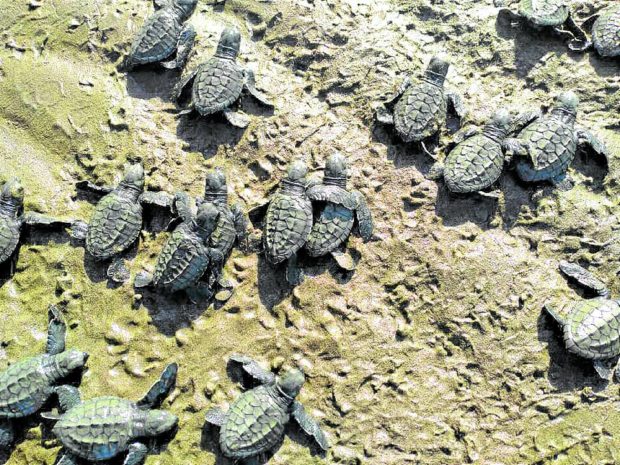
FREEDOM CALLS Baby olive ridley sea turtles crawl back to their natural habitat in Tayabas Bay in Sariaya, Quezon province, after they are released into the sea on Feb. 5 by villagers and fishermen who took care of the hatchlings. —PHOTO COURTESY OF SHERWIN ROSALES
LUCENA CITY—Numerous “baklad” or huge stationary fish traps sunk into the bottom of Tayabas Bay in Quezon province pose deadly threats to sea turtles, locally known as “pawikan,” according to an environmentalist group.
“The presence of baklads at the bottom of the bay is a very serious threat to the survival of the marine turtles,” Jay Lim, project officer of Tanggol Kalikasan, a public interest law office that advocates environmental protection, disclosed in an interview on Friday.
According to Lim, fishermen should not do anything to harm the turtles since they are the ally of small fishermen, explaining that the presence of the marine reptile species in a fishing area indicates a balanced marine ecosystem and abundant supply of fish.
Lim said a team of local government fish wardens (“bantay dagat”) in the coastal town of Agdangan recently demolished at least 17 fish traps in their municipal waters after receiving complaints from small fishers who blamed their diminished catch on the presence of baklad in their fishing area.
“Even juvenile fish could not escape from the baklads,” he explained.
Ban the contraption
Lim said they also recorded numerous beaching of dead turtles from the bay that suffocated after getting entangled in the fish traps.
Lim called on other local governments along the coast of Tayabas Bay and the Bureau of Fisheries and Aquatic Resources to prohibit the use of baklad for the sake of small fishers and the preservation of the gentle marine turtles.
“The efforts to preserve and protect the turtles in several nesting sites in coastal villages will be in jeopardy if the baklads will remain untouched,” he said.
Only last Feb. 16, village officials and fish wardens in Sariaya town released 150 olive ridley sea turtles into Tayabas Bay.Sanctuary
The freed baby turtles were the last batch of hatchlings this year’s nesting season, said Lim, quoting information from Sherwin Rosales, fishery technician at the municipal government’s agriculture office.
“There were only around 1,000 baby turtles that were successfully hatched and released this year compared to more than 2,000 last year,” Lim reported.
The Sariaya coastline, host to many beach resorts and other tourist-oriented businesses, serves as a sanctuary to turtles that usually come to lay and hatch their eggs from October to December.
The hatchlings of different sea turtle species were cared for by fishermen, fish wardens and the local government in five nesting sites in the villages of Castañas, San Roque, Guisguis, Bignay 1 and Bignay 2.